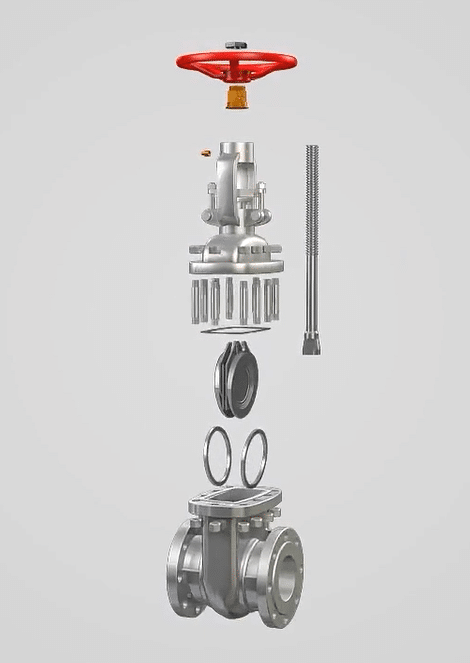Views:
Share:
Explanation of Valve Structure and Parts Terminology
- Body: the main part of valves that are directly connected to pipelines (or machinery equipment) and control the flow of media
- Bonnet: the main part that connects the valve body and forms a pressure chamber with the valve body (or with other parts such as diaphragms)
- Closure member: a general term for parts used to cut off or regulate the flow of media, such as the wedge in a gate valve
- Disc: the closure member in globe valves, check valves, etc.
- Seat ring: the part that are installed on the body and forms a sealing pair with the closure member
- Sealing face: the two contact surfaces between the closure member and the valve seat (valve body) are tightly attached and provide sealing function
- Stem: the main part that transmits the opening and closing force to the closure member
- Stuffing box: the part on the bonnet or the body in which the packing is filled to prevent leakage of media from the stem
- Gland: the part used to compress packing to achieve sealing performance
- Packing: the filler filled in the stuffing box to prevent leakage of media from the stem
- Yoke: the part on the gland or the body used to support the stem nut and transmission mechanism
- Back seat: a sealing structure to prevent media leakage to the stuffing box when the valve is fully opened
- Wedge: the closure member of gate valves
- Single wedge: a rigid wedge structure cast integrally
- Double wedge: consists of two wedges
- Flexible wedge: a type of wedge that can generate elastic deformation
- Ball: the closure member of ball valves
- Disc: the closure member of butterfly valves
- Diaphragm: the closure member of diaphragm valves
- Plug: the closure member of plug valves
- Hinge pin: the fixed axis around which the disc rotates in swing check valves
- Hinge: the part that connects disc and hinge pin and rotates around the hinge pin in swing check valves
- Face to face dimension: for through way type, it refers to the distance from inlet end to outlet end; for angle type, it refers to the distance from inlet (or outlet) end to outlet (or inlet) axis
- Type of construction: the main feature of various types of valves in structure and geometry
- Through way type: valve body shape with inlet and outlet axes overlapping or parallel to each other
- Angle type: valve body shapewith inlet and outlet axes perpendicular to each other
- Y-type: valve body shape with a straight path and a acute angle between the position of the valve stem and the axis of the valve body path
- Three-way type: valve body shape with three path directions
- T-pattern three way: a T-shaped three-way pattern of the path of plug or ball
- L-pattern three way: a L-shaped three-way pattern of the path of plug or ball
- Balance type: a structure that uses medium pressure balance to reduce axial force on the valve stem
- Lever type: a structure that uses the lever to drive the closure member
- Normally open type: the mechanism form in which the closure member is automatically in the open position when there is no external force acting
- Normallyclosed type: the mechanism form in which the closure member is automatically in the closed position when there is no external force acting
- Steam jacket type: various types of valves with steam heating jacket structure
- Bellows sealed type: various types of valves that use bellows as the main seal for the valve stem
- Type of connection: the various methods used for connecting valves to pipelines or machinery equipment (such as flange connection, threaded connection, welding connection, etc.)
- Electric actuator: drive device for opening, closing or regulating valves using electricity
- Pneumatic actuator: drive device for opening, closing or regulating valves with air pressure
- Hydraulic actuator: drive device for opening, closing or regulating valves with hydraulic pressure
- Electro-hydraulic actuator: drive device for opening and closing valves with electricity and hydraulic pressure
- Pneumatic-hydraulic actuator: drive device for opening and closing valves with air pressure and hydraulic pressure








